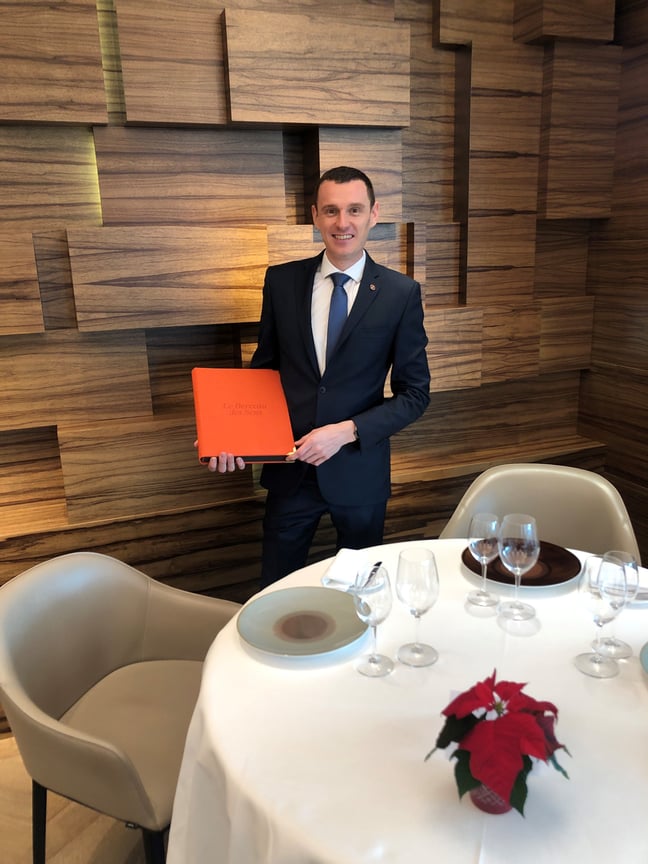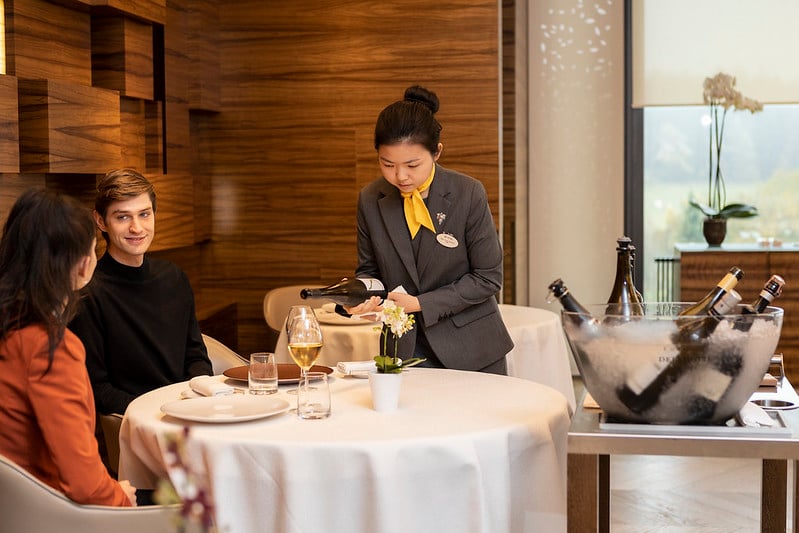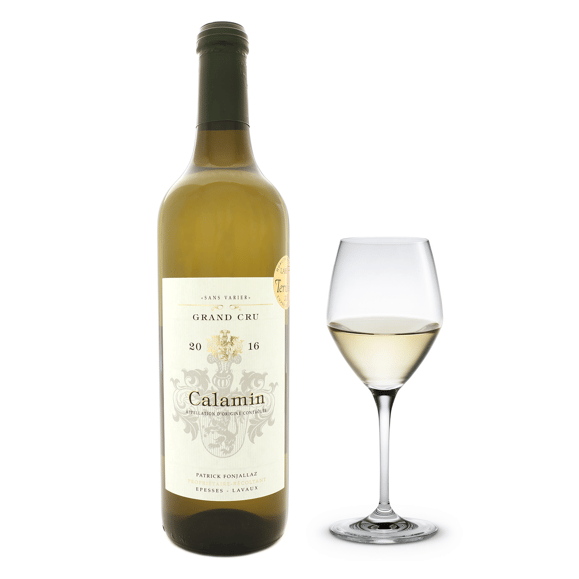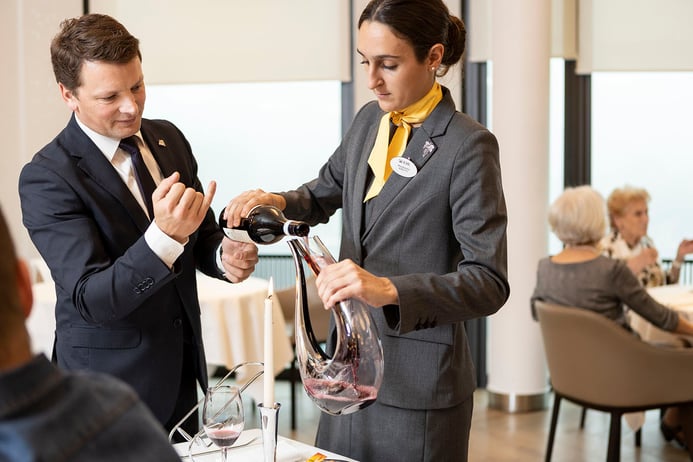Young EHL students are faced with the daunting task of mastering grape names, wine regions, flavors, along with some artful wrist action in just 10 days as part of their Service Skills trainee program. Head wine teacher and Meilleur Ouvrier de France, Thomas Fefin, explains the main stops along the wine teaching journey at the prestigious Michelin star fine dining restaurant, le Berceau des Sens.

Thomas Fefin at the Berceau des Sens
Although there are many wine courses, degrees and accreditations that can be gained in order to teach this subject, I’m a great believer in years of practical, hands-on experience. One can spend hours reading up on the theory, but in the end, it’s the tasting, experimenting and serving that speak volumes.
For any student interested in making wine part of their profession, it’s vital to travel the world gathering experiences from different wine-producing countries, working in the vineyards, serving in restaurants, visiting the trade fairs and really preparing the palate to store one’s wine history within the taste buds.
I have worked all over Asia as a maître d’, and more recently at Le Gabriel in Paris as restaurant director. These are the qualifications that got me my position as Head Sommelier at EHL where I currently manage the wine list and teach the trainee students alongside my colleague, Samuel Boissy, who has been at EHL for over 7 years. We share 2 teams of students during the lunch and dinner shifts, striving to make them feel knowledgeable and comfortable serving wine in a fine dining context with all the intricate codes this involves.
The chronology of wine service
Most of our students begin on a Monday morning never having served wine in their lives, some have never even set foot in a fine dining establishment before. Everyone has to experience working at all the 4 different work stations of the restaurant, which includes wine serving. Students are pre-briefed before their first practice session and are taken through a precise overview of the program.

The first practical step for me is to explain the chronology of the wine and drinks service during the course of a meal. Just because you might know a bit about wine, doesn’t mean you know how and when to serve it. The importance of timing cannot be underestimated. These are the most important stages that get repeated and practiced over and over again:
- Aperitif with trolley
- Ordering of the courses
- Wine list to the guest
- Water, extras and upselling
- Beverage pouring
- Coffee and tea service
Wine knowledge
On day 1, students are given a wine folder that contains information on all the wines by the glass available on the BDS trolley: 3 whites, 4 reds, 1 dessert, 2 champagnes. The folder includes wine names, grape varieties, countries of origin, flavors and the 5 main wine characteristics: sweetness, acidity, tannins, alcohol and body.
Students learn the different terms such as dry, light, sharp, citrusy, fruity, woody; how to distinguish a Calamin Grand Cru of the local Lavaux region from an Austrian Riesling, for instance; and the importance of the vintage, especially for red wines. I teach them specific wine details concerning balance and temperature, e.g. white wines should not be too cold because it destroys their aromas; red wine should be at ‘room temperature’ (approximately 18 degrees), anything above that will result in the alcohol levels feeling out of balance.

Image Credits: Clos de la République
For the students who feel naturally comfortable around wine, I enhance the level of performance and ask them to decant bottles, change glasses according to the type of wines and also help out other trainees who may be feeling less confident. It’s important to work as a team.
Towards the end of each service, I gather my wine team to exchange our respective feedback on how the shift went, what they have learnt, what could be improved. At the end of their 2 weeks’ training session, each student has to complete an online Service Skills test, which includes what they have learnt as wine waiters.
Pouring skills
Students practice their pouring skills first with water – bien sur! – no wasting the wine here. Their main areas of focus are gesture, quantity and glass type. Their movements around the table, especially when pouring, should be like those of a ballet dancer: graceful, light, elegant and precise. Not straight and stiff like a pillar! Whatever the wine, the quantity poured is always 10dl, which comes to approximately 7 glasses per bottle.
The bottle’s wine label should be facing the guest. The wrist should be flipped at the correct angle when retracting the bottle after pouring, with a napkin in the other hand to wipe the tip of the bottle to avoid any drops on the table cloth. Students spend a lot of time practicing how to open bottles, especially champagne which can be dangerous. The cork should always be covered by the hand.
Common mistakes
We, the trainers, are like hawks watching the students’ every move. There are some frequently-committed mistakes that we try to avoid from the offset, for example: using the wrong glass, over-pouring, forgetting that a lady’s glass must be always served first, unnecessary spillages, etc.
I follow each student attentively throughout every operation around the table and make myself available when a situation becomes challenging or if they need help. There are so many unwritten codes that accompany the fine art of serving, I make sure that I am always an example for my students to follow at any moment during the fine dining experience. In some ways, we are all performing a very discreet show.
Conclusion
The EHL environment and the BDS premises provide me with the best tools to perform my work and the training. Teaching absolute beginners the basics in wine knowledge and service is certainly different from my former job, but the passion and respect for wine remains the same. Moving from the F&B industry into the teaching arena embodies for me all the best values of being a Meilleur Ouvrier. My greatest pleasure and goal is to create vocation and curiosity about this industry within the heart of each student.





